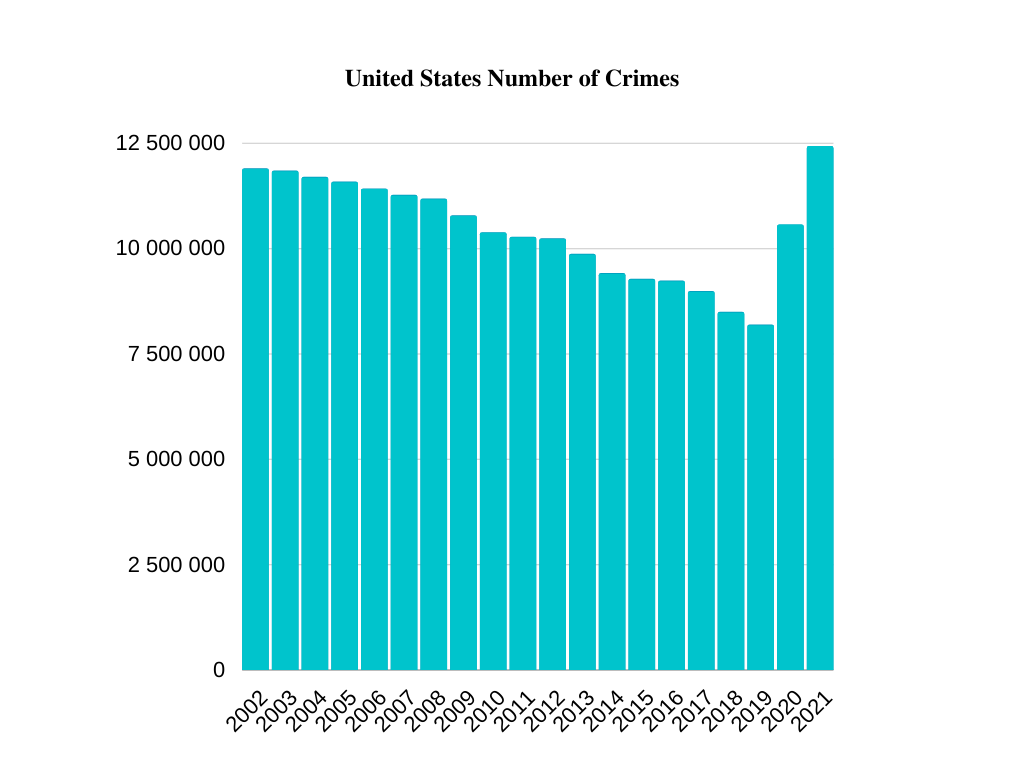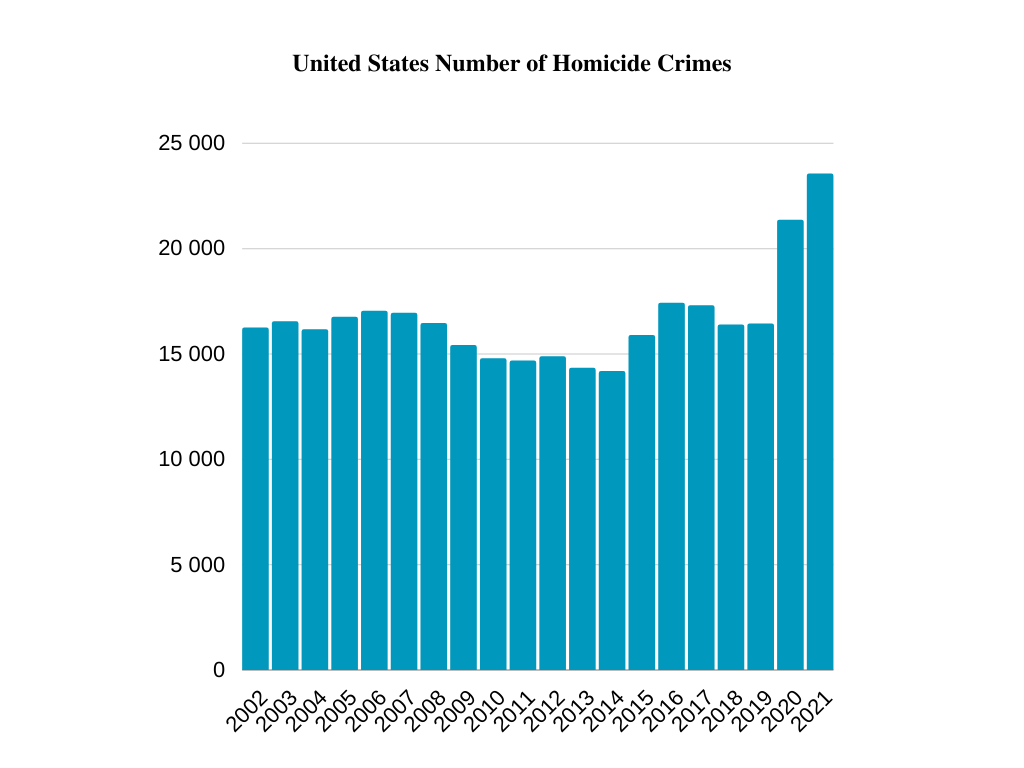Analysis of Homicide Increase in the US
The increase in the overall level of crime, and homicide, in particular, is a severe problem in today’s US society. According to public data, the notable increase began in 2020, when the number of registered cases in the category mentioned above increased by 27 percent (Lopez, 2022, par. 1). Thousands more Americans were killed, bringing the homicide rate in the United States back to levels not seen since the beginning of the 21st century (Lopez, 2022, par. 2). The consequences are felt in different ways across the country. Historically, shootings have been centered in disadvantaged, minority populations; in a typical American metropolis, a small number of neighborhoods are responsible for the majority of the violence (Lopez, 2022). As a result, this negative trend has several reasons requiring a detailed analysis using statistics and third-party research in sociology and criminology, which will help identify the primary source of the events.
Figure 1 determined the number of crimes in the United States over the past 20 years and was compiled according to a legitimate source that keeps statistics. Based on this information, one can conclude that since the beginning of the 21st century, crime in the country has been gradually decreasing, but in 2020 there was a substantial increase. During that year, the most significant event for the public was the beginning of the COVID-19 pandemic, which caused economic and social instability (Mekouar, 2022). Based on available research data, mass hysteria began among Americans, with frequent instances of collective panic leading to looting and theft (Mekouar, 2022). Moreover, organized crime also began to take advantage of the situation and significantly influenced this trend (Mekouar, 2022). Thus, a superficial analysis determines the source of the increase in the overall number of crimes.
However, it is also necessary to analyze the concept of what constitutes mass hysteria. In order to establish a more precise description of mass hysteria and separate it from any unnecessarily negative connotations, experts have advocated referring to the phenomena as “collective obsessional behavior” (Cohut, 2018). According to experts who have studied this phenomenon, it is a sort of “psychogenic sickness,” or a condition that originates in the mind rather than the body (Cohut, 2018, par. 10). On the other hand, physiological symptoms are frequently not illusory but highly genuine (Cohut, 2018). Mass hysteria is also known as a “conversion disorder,” when an individual’s nervous system is affected by physiological symptoms without a medical cause of sickness in response to psychological anguish (Cohut, 2018, par. 11). As mass hysteria, or collective obsessional behavior, may take so many various forms, it is hard to give a definitive description or accurately define it (Cohut, 2018). As a result, one may conclude that the phenomenon that generates destructive behavior in society is still poorly understood and thus cannot shed light on the causality of citizens’ behavior during the pandemic.
Figure 2 represents the number of crimes that fall exclusively into the homicide category. Along with the available data, there is the opinion expressed by independent experts that one important event, in particular, is an integral part of this issue (Gramlich, 2021). The death of George Floyd in custody on May 25, 2020, led to a series of public outcry (Gramlich, 2021, par. 2). Many political, ethnic, and social groups are engaged in armed conflicts across the country (Sganga, 2022). Moreover, the Capitol storming incident also led to many unintentional and intentional homicide cases (Sganga, 2022). Such a trend could potentially have a substantial impact on the graph above. Thus, state security forces’ inappropriate use of force is one of the leading causes.
Another key reason lies in a critical clause in the United States Constitution. Implicit in this case is the amendment allowing civilians to possess firearms (Mekouar, 2022). Furthermore, they have the right to use guns for self-defense and when a person trespasses on private property (Mekouar, 2022). Based on the theories suggested by criminologists, the use of firearms instead of edged weapons or improvised objects is much more likely to result in fatalities (Mekouar, 2022). Such a conclusion logically correlates with the factor of mass hysteria observed in American society in the wake of current events.
Compiling the facts described above, one can conclude that the prevailing nervousness in people encourages them to open fire immediately at the first sign of danger. According to various researches, such situations have rarely been resolved peacefully in recent years, preferring a forceful approach (Gramlich, 2021, par. 9). Additionally, this tendency is also applicable to those social elements who engage in illegal activities, particularly robbery (Gramlich, 2021). As citizens of their own country, criminals are just as psychologically pressured by the pandemic and unstable social situation (Gramlich, 2021). Given all the information provided, it is possible to conclude that most social groups are victims of the current state of affairs.
An additional factor in this situation is the measures that society opposes to the current issue. In the near run, there is strong support favoring policing — especially more targeted enforcement, which focuses on the individuals and locations most likely to be violent (Lopez, 2022). The police collaborate with other social agencies in some of these efforts to help violent perpetrators leave that life (Lopez, 2022). Preschool programs, summer employment efforts, raising the school dropout age, greening abandoned areas, additional lighting, and increased drug treatment are among the remedies that experts endorse in the long run (Lopez, 2022). Gun restrictions and more significant alcohol tariffs are also supported by evidence (Lopez, 2022). The short-term and long-term categories are not mutually exclusive; they can complement one another and are to be required to reverse the current murder rate and avoid future rises (Lopez, 2022). Thus, there is a tendency to stabilize the situation in the future and take preventive measures to avoid its recurrence.
In conclusion, a superficial and detailed analysis demonstrated a causal relationship between the increase in crime and the possible solutions. The increase in the number of crimes is mainly related to the COVID-19 pandemic and related economic and socio-psychological problems. Homicide issues are a consequence of political and social phenomena that reveal problems with the current structure of the police institution. An additional cause of the phenomenon mentioned above is the right of people to use firearms, in particular the way they use them. Moreover, methods to address this adverse trend in the short and long term are being worked out. From this, one can conclude that there are ways to stabilize, not only by the state but also by independent humanitarian and forensic experts. However, more research is needed on mass hysteria, identifying the causes of its emergence and methods of introducing a recessive phase. Otherwise, further crime and homicide spikes are possible, based on all the conclusions given in this paper.
References
Cohut, M., PhD. (2018). Mass hysteria: An epidemic of the mind? Medical News Today. Web.
Disaster Center. (n.d.). [Statistical data on total crime rating and homicide rating in U.S. between 2002 and 2019]. United States crime rates 1960 to 2019.
Gramlich, J. (2021). What we know about the increase in U.S. murders in 2020. Pew Research Center. Web.
Lopez, G. (2022). How the Spike in Murders Impacted the U.S. The New York Times.
MacroTrends. (n.d.). [Statistical data on total crime rating and homicide rating in U.S. between 2020 and 2021]. U.S. crime rate & statistics 1990–2022. Web.
Mekouar, D. (2022). Why Homicide Rates in US Spiked 30% During COVID Pandemic. VOA.
Sganga, N. (2022). Homicides in major American cities increased in 2021, new study finds. CBS News.
Appendix A

Note:
- The data for years 2002-2019 was collected from the report of Disaster Center. (n.d.). United States crime rates 1960 to 2019. Web.
- The data for years 2020-2021 was collected from the report of MacroTrends. (n.d.). U.S. crime rate & statistics 1990–2022.
Appendix B

Note:
- The data for years 2002-2019 was collected from the report of Disaster Center. (n.d.). United States crime rates 1960 to 2019. Web.
- The data for years 2020-2021 was collected from the report of MacroTrends. (n.d.). U.S. crime rate & statistics 1990–2022.
